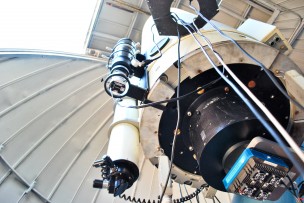
Shannon Welch/Photo Editor
Have you ever looked up into the sky, wondering what was up there and if you would ever find out? While most of us just have a romantic interest in the stars—looking up at their beauty and mystery, and wondering about aliens and our own mystical origins—the University’s Astronomy department has been taking this fascination to an empirical level, conducting research about young stars and black holes.
Continuing The Argus’ series on the research being done in the sciences, we zoom out from the molecular structures being studied in the biology labs to the vast world beyond our planet being studied by the Astronomy department. Three academics are currently conducting research: Astronomy Professor and Department Chair William Herbst, Research Assistant Professor of Astronomy Roy E. Kilgard, and Associate Professor Edward C. Moran.
Herbst, who also serves as John Monroe Van Vleck Professor of Astronomy, Director of Van Vleck Observatory, and Director of Graduate Studies, researches star and planet formation. He studies very young stars—a few million years old—and the discs, or nebulae, that surround them to try to examine what they’re doing and how it relates to the formation of planets.
The research will help us understand what happened in our own solar system during its conception. Herbst has collaborated with many undergraduate and graduate students at the University as well as professors all around the world, including in Germany, Uzbekistan, and the United States.
Herbst uses the Hubble telescope and telescopes in Hawaii, Uzbekistan, and Middletown—Wesleyan’s own small telescope in the Van Vleck Observatory—to measure the light that comes from a disc and analyze changes in color, spectrum, and brightness.
“We try to make a story out of it…it’s like a kind of detective work,” he said.
He is currently examining a blinking binary star system—two stars orbiting each other—that are embedded in a ring similar to Saturn’s. Herbst has been studying this particular system for the past 15 years to see how it will change, evolve, and grow over time as planets are born.
In contrast to Herbst’s studies of the birth of planets and stars, Kilgard and Moran concentrate their research on what happens after stars die, and after they become black holes.
There are two different types of black holes: large and small. Large black holes are extremely massive, weighing between 10 million to a billion times the mass of the sun. There is a supermassive black hole at the center of our own galaxy. Small black holes, on the other hand, weigh a minimum of three times the mass of the sun, and they form when a single massive star dies.
The origin of large black holes is a mystery. Kilgard researches the dominant theory of large black hole creation—that they form hierarchically, with many small black holes combining to create a single massive one.
“[We’re investigating] how big you can make a single black hole from a single star, and how much matter can be retained in a black hole when it dies,” Kilgard said.
Kilgard uses X-ray telescopes to search nearby galaxies for the biggest examples of small black holes and then looks to where they are formed and the environments in which they exist to build a picture of the circumstances required for formation.
He then tries to find empirical evidence relating these smaller black holes to others, asking if they could have been formed during the same time and in the same area to combine and create a massive black hole.
Moran also studies black holes but concentrates on the largest type, known as supermassive black holes. There are two key mysteries about supermassive black holes: where they come from and how their mass affects the galaxy around them.
Moran looks at galaxies with black holes at the center to obtain a better understanding of how these ‘smaller’ black holes grow together with their galaxies. One theory for the creation of large galaxies with massive black holes at the center is that galaxies move, and over time they could ram into each other. But galaxies don’t always form with black holes at the center. As in the proverbial chicken and egg situation, it is unclear whether galaxies with black holes just started off that way, or if smaller galaxies combined to form a large one around a hierarchically built massive black hole.
So next time you wistfully look up at the dark night sky and wonder what’s going on up there, take a moment to think about the birthplace of planets and stars and the different types of mysterious black holes being studied right at the top of Foss Hill.
Comments are closed